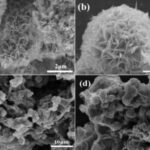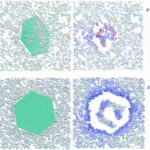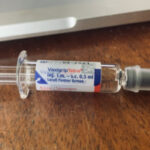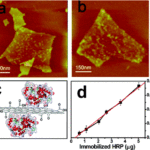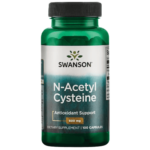November 19, 2024 5g, Graphene, Neurocontrol, Scientific alternative studies
However, the hazardousness of graphene oxide and its derivatives, including graphene quantum dots, to human health seems not only established but assured.
Clothing and graphene oxide. Remarkable is the large amount of research
Reference study
Zhao, J.; Deng, B.; Lv, M.; Li, J.; Zhang, Y.; Jiang, H.; Fan, C. (2013). Graphene Oxide-Based Antibacterial Cotton Fabrics. Advanced Healthcare Materials, 2 (9), pp. 1259-1266 https://doi.org/10.1002/adhm.201200437
Analyzed facts
The article by (Zhao, J.; Deng, B.; Lv, M.; Li, J.; Zhang, Y.; Jiang, H.; Fan, C. 2013) develops a method for “fixing GO sheets on cotton fabrics that exhibit strong antibacterial property and long service life after washing“.
Graphene oxide sheets are woven into cotton fibers and remain fixed there, as shown in the figure below :
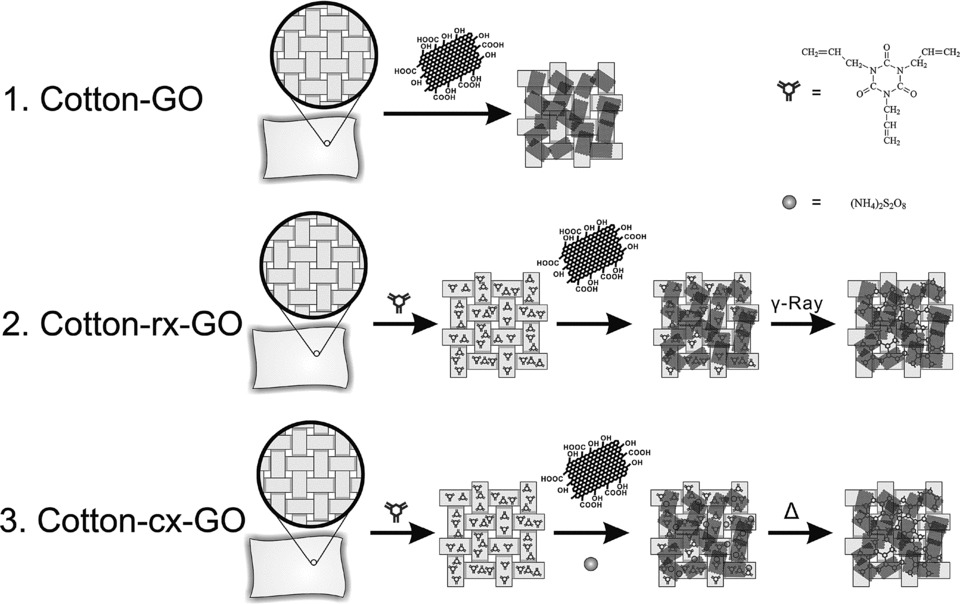
They further state that “GO-based antibacterial cotton fabrics are prepared in three ways : direct absorption, radiation-induced cross-linking, and chemical cross-linking. In addition, these fabrics can kill 90% of bacteria even after 100 washes.
GO-modified cotton fabrics do not cause irritation to the skin of rabbits, as shown in animal tests“.
However, these benefits of GO graphene oxide are completely contradicted by cytotoxicity studies of graphene-based GBM materials in contact with skin (Pelin, M. et al., 2017).
In fact, the in vitro skin toxicity study with graphene oxide compounds yielded troubling results after 72 hours, inducing damage to cell viability as evidenced by damage to mitochondria and plasma membranes.
It was concluded that “high concentrations and prolonged exposure times of FLG and GO could affect mitochondrial activity associated with plasma membrane damage, suggesting cytotoxic effects“.
Furthermore, it is pointed out that “in contrast to the absence of antiproliferative properties, the effects of FLG and GO on HaCaT cells appear to be associated with significant damage to the plasma membrane, as assessed by cellular uptake of propidium iodide“.
Another study, even more damning in its conclusions, confirms the harmful effects of graphene oxide on the skin (Liao, KH; Lin, YS; Macosko, CW; Haynes, CL, 2011).
Researchers measured mitochondrial activity in human skin fibroblasts to determine the cytotoxicity of graphene oxide and graphene sheets.
Using water-soluble tetrazolium salt (WST-8), trypan blue exclusion, and reactive oxygen species (ROS), they found that compacted graphene sheets were more damaging to mammalian fibroblasts than less dense graphene oxide.
To these findings, the researchers add other conclusions.
In particular, they observed that “at the smallest size, graphene oxide showed the highest hemolytic activity, while aggregated graphene sheets showed the lowest hemolytic activity.
Coating graphene oxide with chitosan almost completely eliminated the hemolytic activity“.
Although chitosan is not the subject of this entry, its very relevant role in new food packaging films, hydrogels and wound healing dressings is worth mentioning.
These studies contradict the convincing and clear evidence of the advantages and benefits of graphene oxide.
Other research
It is striking how much research has been done on textiles and graphene oxide to create all kinds of clothing.
For example, (Cai, G.; Xu, Z.; Yang, M.; Tang, B.; Wang, X. 2017) developed a method to functionalize cotton fabrics with graphene oxide by thermal reduction.
In their study, the researchers confirm the “good electrical conductivity“, the permanence of graphene oxide in fabrics without “affecting electrical conductivity” and the “hydrophobic and UV-blocking properties“.
These details are very relevant since the electromagnetic absorption properties of graphene oxide are well known.
This would turn cotton fabric clothing (although it could be other materials) and graphene oxide into a receiving antenna that would amplify the signal emitted by 5G devices.
It also affects UV blocking, as graphene oxide can be degraded by exposure to ultraviolet light, as shown in research by (Bai, H.; Jiang, W.; Kotchey, G.P.; Saidi, W.A.; Bythell, B.J.; Jarvis, J.M.; Stella, A.(2014).
In their paper, Bai, et al. explain that the Fenton reaction (an oxidation process that generates highly reactive hydroxyl radicals) and exposure to UV radiation affect the stability of graphene oxide.
This is clarified with the following statement : “It is widely accepted that the oxidative species of the Fenton mechanism consist of radicals, including the highly reactive hydroxyl radical, and that ultraviolet (UV) irradiation accelerates the production of these radical species“.
In the case of the authors (Gao, Y.; Ren, X.; Zhang, X.; Chen, C. 2019), in addition to confirming the interaction of UV light in the degradation of graphene oxide, some troubling claims are made, such as, “Currently, comparative data on the colloidal stability and toxicity of graphene oxide (GO) processed with ultraviolet (UV) and visible (VL) light are rather limited“.
This means that the authors openly acknowledge the lack of research on the harmful effects of graphene oxide in 2019, when graphene oxide began to be widely used in the industrial and manufacturing ecosystem.
On the other hand, they correlate graphene oxide with the variable of UV exposure, showing that the molecular structure degrades, producing graphene quantum dots, also called “quantum dots,” with which memristors are curiously formed.
The authors conclude that “exposure of graphene GO oxide to sunlight enhances its physicochemical transformations.
This is similar to the phenomenon of photoreaction of nanomaterials dissolved in fresh water, their UV/VL (ultraviolet/visible light)-induced transformation and degradation”.
They also add that “both UV and VL irradiation can make GO graphene oxide much more stable and mobile in tap water and natural surface water than expected….. When UV radiation is used to degrade GO during water treatment, irradiation time is a key operational parameter…”
This is very important because it could be a way to eliminate or counteract the effects of graphene oxide in the human body.
However, “the toxic effects of UV/VL transformed GO samples are measured by inactivation of E. coli and S. aureus ….. UV exposure has a strong influence on the toxic effect of GO“.
This means that in the degradation process of graphene oxide quantum dots, toxicity problems for animals and the environment may occur.
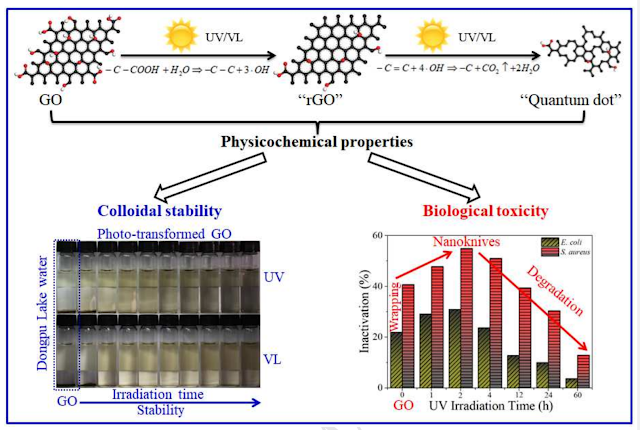
In this regard, the scientific literature has been analyzed and the following key points have been brought out.
(Wang, T.; Zhu, S.; Jiang, X., 2015) analyzed the toxicity of graphene quantum dots and added :
1. “Graphene quantum dots (GQDs) generate intrinsic fluorescence and improve the aqueous stability of graphene oxide (GO), while maintaining broad chemical adaptability and high adsorption capacity“.
This statement is important because it means that the adsorption capacity of graphene has increased and with it the ability to immobilize enzymes in the human body.
2. “We found that GQDs (graphene quantum dots) did not show any noticeable influence in mice due to their small size, while GO appeared to be toxic, even causing the death of mice due to the aggregation of GO inside the mice. In conclusion, GQD has no apparent toxicity in vitro and in vivo, even in multidose situations“.
This suggests that the hypothesized toxicity of GQDs (graphene quantum dots) is reduced by exposure to sunlight or ultraviolet light compared to undegraded graphene oxide GO.
3. Other authors such as (Chong, Y.; Ma, Y.; Shen, H.; Tu, X.; Zhou, X.; Xu, J.; Zhang, Z. 2014) state that “detailed analysis of infrared spectra revealed that GO uptake disrupts the integrity of the cell membrane, removing the lipid bilayer and causing hemolysis and aberrant shapes.
In contrast, GQDs alter only the lipid structure and conformation, resulting in aberrant cells”.
The researchers thus confirm that the toxic effects of graphene quantum dots are slightly less than those of the same GO graphene oxide from which they are derived.
However, it should not be forgotten that GQD tests on red blood cells have caused the formation of aberrant cells.
This could explain the frequent occurrence of circulatory problems, heart inflammations, pericarditis, myocarditis and even degenerative neuromuscular diseases.
In fact, the study by (Qu, G.; Wang, X.; Wang, Z.; Liu, S.; Jiang, G. 2013) states that in their tests, “QDs (quantum dots) caused great damage to macrophages through intracellular accumulation of QDs along with the generation of reactive oxygen species ROS, especially for QDs coated with PEG-NH2“.
This indicates that the toxicity of graphene oxide quantum dots (degraded graphene oxide) leads to the release of free radicals in reactive oxygen species (ROS) and damage to macrophages (cells that destroy antigens in our body), especially when the quantum dots are coated with PEG-NH2, a polyethylene glycol compound that would theoretically protect the body from graphene toxicity.
By the way, all this has already been analyzed in the entry on the interaction of graphene oxide with brain cells.
Returning to the analysis of the study by (Cai, G.; Xu, Z.; Yang, M.; Tang, B.; Wang, X. 2017) on the functionalization of cotton fabrics with graphene oxide and its anti-UV properties, it can be deduced that its goal is to preserve the integrity of graphene oxide in textile products to prevent its degradation and conversion into graphene quantum dots.
By the way, all this has already been analyzed in the entry on the interaction of graphene oxide with brain cells.
Returning to the analysis of the study by (Cai, G.; Xu, Z.; Yang, M.; Tang, B.; Wang, X. 2017) on the functionalization of cotton fabrics with graphene oxide and its anti-UV properties, it can be deduced that its goal is to preserve the integrity of graphene oxide in textile products to prevent its degradation and conversion into graphene quantum dots.
Other studies
Other studies related to cotton fabrics and graphene oxide seem to confirm their thermal stability.
According to (Krishnamoorthy, K.; Navaneethaiyer, U.; Mohan, R.; Lee, J.; Kim, SJ 2012), “thermogravimetric analysis (TGA) showed that GO-loaded cotton fabrics have better thermal stability than raw cotton fabrics“.
Furthermore, based on (Rani, KV; Sarma, B.; Sarma, A. , 2018), graphene oxide would not only serve to intertwine with cotton, but could also completely cover it through the dipping process, resulting in better electrical conduction properties.
Other similar investigations include those by Ren et al. (2017), Sahito et al. (2015), and Shateri-Khalilabad and Yazdanshenas (2013), who analyze the conductive properties in flexible cotton and graphene oxide fabrics hot-pressed with negatively charged graphene oxide.
Graphene oxide has also been introduced into polyester fabrics by printing and hot-pressing techniques (Cao, J.; Guan, X.; Wang, Y.; Xu, L., 2021).
Similar to other studies (Cai, G.; Xu, Z.; Yang, M.; Tang, B.; Wang, X. 2017), the fabric exhibits electrical conductivity, friction resistance, and washability.
Graphene oxide can also be introduced by dyes, as shown by Fan et al. (2020), Fang et al. (2020) and Fugetsu et al. (2010), which improves its electrostatic properties and electrical conductivity.
In this context, it is also worth mentioning the work of (Kowalczyk, D.; Fortuniak, W.; Mizerska, U.; Kaminska, I.; Makowski, T.; Brzezinski, S.; Piorkowska, E. 2017), in which it is shown that fabrics coated with xerogels in 0.5-1.5 percent of their weight in rGO-reduced graphene oxide improve antistatic properties and surface and volumetric strength.
Xerogels are a type of high-porosity gel that impart water repellency and electrical conductivity to treated fabrics.
Other research focuses on the development and fabrication of textiles for electromagnetic interference shielding using graphene oxide and silver (Ghosh, S.; Ganguly, S.; Das, P.; Das, T.K.; Bose, M.; Singha, N.K.; Das, N.C., 2019), where textiles with 27.36 dB resistance in the X band (8.2-12.4 GHz) have been obtained.
In addition to protection against electromagnetic interference, a graphene oxide fabric with high microwave absorption capacity was obtained, as reported by (Gupta, S.; Chang, C.; Anbalagan, A.K.; Lee, C.H.; Tai, N.H. 2020) in their study.
Interestingly, this fabric is designed to operate in the X-band (8.2-12.4 GHz).
Polypropylene nonwoven fabrics can also be developed for the fabrication of graphene-based wearable sensors, thus achieving “smart fabrics”.
This is the approach of (Hasan, MM; Zhu, F.; Ahmed, A.; Khoso, NA; Deb, H.; Yuchao, L.; Yu, B., 2019).
Applications cited by the authors include “filter membranes used in clothing and their potential industrial use due to improved breathability, durability, absorbency, and filtration properties.
PP (polypropylene) nonwovens are widely used in the development of wearable items such as clothing“.
In this paper, a membrane based on graphene oxide and polypropylene fabric that can act as a pressure sensor is investigated.
Previously, Du, D.; Li, P.; Ouyang, J. (2016) developed graphene-coated fabrics to create sensors capable of detecting pulse and respiration.
These studies open up the possibility of developing wearable electronics based on flexible fabrics that can overcome the limitations of rigid electronics (Khan, J.; Mariatti, M., 2021).
However, the authors are not aware of or do not want to overcome the danger of graphene oxide ; in fact, according to them, “graphene is the leading candidate among other forms of carbon (to develop electronic textiles) due to its exceptional properties and non-toxicity“.
For this reason, it seems essential for the fabric to have thermal conductivity and electromagnetic absorption capabilities, as can be seen from their tests.
Polyester modified with sodium hydroxide showed the best results, with a 30 percent improvement in absorption and a 15 percent improvement in thermal conductivity compared to untreated polyester.
Another example of smart garments with graphene oxide are sports bras (Shathi, MA; Chen, M.; Khoso, NA; Rahman, MT; Bhattacharjee, 2020), developed using the graphene oxide dyeing technique, which “improves electrical conductivity and tensile strength as well as washing stability and low impedance,” concluding that “the dry pad polymerization method can potentially be used to develop graphene-coated wearable electronic fabrics for biomedical and health monitoring devices“.
Another type of fabric in which graphene oxide has been introduced is polyethylene terephthalate, which is commonly used in the manufacture of clothing and beverage containers (Liu, X.; Qin, Z.; Dou, Z.; Liu, N.; Chen, L.; Zhu, M., 2014), where structural stability of the fabric and high electrical conductivity are also sought.
Screen printing has also been investigated for the application of graphene oxide, as shown in the work of Qu, J.; He, N.; Patil, SV; Wang, Y.; Banerjee, D.; Gao, L. (2019).
Here, the authors summarize that “graphene-based e-textiles have attracted great interest due to their promising applications in sensors, protection, and wearable electronic devices.
In this work, a scalable screen-printing process and a continuous dry-curing process are presented for fabricating durable graphene oxide (GO) patterns on viscose nonwovens with a controllable penetration depth“.
Final thoughts on the use of graphene oxide in clothing
Clothing made of GO graphene oxide, cotton and other materials could be used to amplify and enhance the reception of 5G electromagnetic waves, facilitate their electrical conductivity and promote neuromodulation processes in subjects already inoculated by so-called “vaccines”.
Graphene oxide has been shown to degrade when exposed to ultraviolet light, as reported by (Gao, Y.; Ren, X.; Zhang, X.; Chen, C. 2019), producing residues of the oxidation process in the form of graphene quantum dots.
In any case, the hazard of graphene oxide and its derivatives, including graphene quantum dots, to human health seems not only proven, but certain.
Because graphene oxide is degraded by sunlight or ultraviolet irradiation, many researchers have developed methods to incorporate tissue protection against these agents (Miao, GY; Zhang, ZZ 2017 | Tang, X .; Tian Tian , M .; Qu, L .; Zhu, S. et al. 2015; Tian, M. et al. 2016).
Because graphene oxide does not degrade in tissue, it retains its electromagnetic radiation absorption properties.
Bibliography
1.Bai, H.; Jiang, W.; Kotchey, GP; Saidi, WA; Bythell, BJ; Jarvis, JM; Star A. (2014). Insight into the Mechanism of Graphene Oxide Degradation via the Photo-Fenton Reaction. The Journal of Physical Chemistry. The Journal of Physical Chemistry C, 118 (19), pp. 10519-10529. https://doi.org/10.1021/jp503413s
2.Cai, G.; Xu, Z.; Yang, M.; Tang, B.; Wang, X. (2017). Functionalization of cotton fabrics through thermal reduction of graphene oxide. Applied surface science, 393, pp. 441-448. https://doi.org/10.1016/j.apsusc.2016.10.046
3.Cao, J.; Guan, X.; Wang, Y.; Xu, L. (2021). Highly conductive polyester fabrics fabricated by graphene oxide printing and hot-pressing. Surface Innovations, 40, 1-8. https://doi.org/10.1680/jsuin.21.00005a
4.Chong, Y.; Ma, Y..; Shen, H.; Tu, X.; Zhou, X.; Xu, J.; Zhang, Z. (2014). The in vitro and in vivo toxicity of graphene quantum dots. Biomaterials, 35 (19), pp. 5041-5048. https://doi.org/10.1016/j.biomaterials.2014.03.021
5.Du, D.; Li, P.; Ouyang, J. (2016). Graphene coated nonwoven fabrics as wearable sensors. Journal of Materials Chemistry C, 4 (15), pp. 3224-3230. https://doi.org/10.1039/C6TC00350H
6.Fan, L.; Tan, Y.; Amesimeku, J.; Yin, Y.; Wang, C. (2020). A novel functional disperse dye doped with graphene oxide for improving antistatic properties of polyester fabric using one-bath dyeing method, 90 (5-6), pp. 655-665. https://doi.org/10.1177%2F0040517519877464
7.Fang, J.; Gao, X.; Cai, X.; Lou, T. (2020). UV protection of silk fabric modified with reduced graphene oxide. China Dyeing and Finishing. https://en.cnki.com.cn/Article_en/CJFDTotal-YIRA202009011.htm
8.Fugetsu, B.; Sano, E.; Yu, H.; Mori, K.; Tanaka, T. (2010). Graphene oxide as dyestuffs for the creation of electrically conductive fabrics. Carbone, 48 (12), pp. 3340-3345. https://doi.org/10.1016/j.carbon.2010.05.016
9.Gao, Y.; Ren, X.; Zhang, X.; Chen, C. (2019). Environmental fate and risk of ultraviolet-and visible-light-transformed graphene oxide : A comparative study. Environmental Pollutio, 251, pp. 821-829. https://doi.org/10.1016/j.envpol.2019.05.010
10.Ghosh, S.; Ganguly, S.; Das, P.; Das, TK; Bose, M.; Singha, NK; Das, NC (2019). Fabrication of Reduced Graphene Oxide/Silver Nanoparticles Decorated Conductive Cotton Fabric for High Performing Electromagnetic Interference Shielding and Antibacterial Application. Fibers and Polymers, 20 (6), pp. 1161-1171. https://doi.org/10.1007/s12221-019-1001-7
11.Gupta, S.; Chang, C.; Anbalagan, AK; Lee, CH; Tai, NH (2020). Reduced graphene oxide/zinc oxide coated wearable electrically conductive cotton textile for high microwave absorption. Composites Science and Technology, 188, 107994. https://doi.org/10.1016/j.compscitech.2020.107994
12.Hasan, MM; Zhu, F.; Ahmed, A.; Khoso, NA; Deb, H.; Yuchao, L.; Yu, B. (2019). Functionalization of polypropylene nonwoven fabrics using cold plasma (O2) for developing graphene-based wearable sensors. Sensors and Actuators A: physical, 300, 111637. https://doi.org/10.1016/j.sna.2019.111637
13.Khan, J.; Mariatti, M. (2021). The Influence of Substrate Functionalization for Enhancing the Interfacial Bonding between Graphene Oxide and Nonwoven Polyester. Fibers and Polymers, pp. 1-11. https://doi.org/10.1007/s12221-021-1386-y
14.Kowalczyk, D.; Fortuniak, W.; Mizerska, U.; Kaminska, I.; Makowski, T.; Brzezinski, S.; Piorkowska, E. (2017). Modification of cotton fabric with graphene and reduced graphene oxide using sol–gel method. Cellulose, 24 (9), pp. 4057-4068. https://doi.org/10.1007/s10570-017-1389-4
15.Krishnamoorthy, K.; Navaneethaiyer, U.; Mohan, R.; Lee, J.; Kim, SJ (2012). Graphene oxide nanostructures modified multifunctional cotton fabrics.. Applied Nanoscience volume, 2 (2), pp. 119-126. https://doi.org/10.1007/s13204-011-0045-9
16.Liao, KH; Lin, YS; Macosco, CW; Haynes, CL (2011). Cytotoxicity of graphene oxide and graphene in human erythrocytes and skin fibroblasts. ACS applied materials & interfaces, 3 (7), pp. 2607-2615. https://doi.org/10.1021/am200428v
17.Liu, X.; Qin, Z.; Dou, Z.; Liu, N.; Chen, L.; Zhu, M. (2014). Fabricating conductive poly(ethylene terephthalate) nonwoven fabrics using an aqueous dispersion of reduced graphene oxide as a sheet dyestuff. RSC Advances, 4 (45), pp. 23869-23875. https://doi.org/10.1039/C4RA01645A
18.Miao, GY; Zhang, ZZ (2017). Anti-UV finish of cotton fabrics with graphene oxide. Dyeing & Finishing, 02. https://en.cnki.com.cn/Article_en/CJFDTotal-YIRA201702010.htm
19.Pelin, M.; Fusco, L.; Leone, V.; Martin, C.; Criado, A.; Sosa, S.; Prato, M. (2017). EDifferential cytotoxic effects of graphene and graphene oxide on skin keratinocytes. Scientific Reports, 7 (1), pp. 1-12. https://doi.org/10.1038/srep40572
20.Qu, G.; Wang, X.; Wang, Z.; Liu, S.; Jiang, G. (2013). Cytotoxicity of quantum dots and graphene oxide to erythroid cells and macrophages. Nanoscale Research Letter, 8 (1), pp. 1-9. https://doi.org/10.1186/1556-276X-8-198
21.Qu, J.; He, N. .; Patil, SV; Wang, Y.; Banerjee, D.; Gao, W. (2019). Screen printing of graphene oxide patterns onto viscose nonwovens with tunable penetration depth and electrical conductivity. ACS applied materials & interfaces, 11 (16), pp. 14944-14951. https://doi.org/10.1021/acsami.9b00715
22.Rani, KV; Sarma, B.; Sarma, A. (2018). Plasma treatment on cotton fabrics to enhance the adhesion of Reduced Graphene Oxide for electro-conductive properties. Diamond and Related Materials, 84, pp. 77-85. https://doi.org/10.1016/j.diamond.2018.03.009
23.Ren, J.; Wang, C.; Zhang, X.; Carey, T.; Chen, K.; Yin, Y.; Torrisi, F. (2017). Environmentally-friendly conductive cotton fabric as flexible strain sensor based on hot press reduced graphene oxid. Carbon, 111, pp. 622-630. https://doi.org/10.1016/j.carbon.2016.10.045
24.Sahito, IA; Sun, KC; Arbab, AA; Qadir, MB; Jeong, SH (2015). Integrating high electrical conductivity and photocatalytic activity in cotton fabric by cationizing for enriched coating of negatively charged graphene oxide. Carbohydrate polymers , 130, pp. 299-306. https://doi.org/10.1016/j.carbpol.2015.05.010
25.Shateri-Khalilabad, M.; Yazdanshenas, ME (2013). Fabricating electroconductive cotton textiles using graphene. Carbohydrate Polymers, 96 (1), pp. 190-195. https://doi.org/10.1016/j.carbpol.2013.03.052
26.Shathi, MA; Chen, M.; Khoso, NA; Rahman, MT; Bhattacharjee, B. (2020). Graphene coated textile based highly flexible and washable sports bra for human health monitoring. Materials & Design, 193, 108792. https://doi.org/10.1016/j.matdes.2020.108792
27.Tang, X.; Tian, M.; Qu, L.; Zhu, S.; Guo, X.; Xu, X. (2015). Functionalization of cotton fabric with graphene oxide nanosheet and polyaniline for conductive and UV blocking properties. Synthetic Metals, 202, pp. 82-88. https://doi.org/10.1016/j.synthmet.2015.01.017
28.Tian, M.; Hu, X.; Qu, L.; Du, M.; Zhu, S.; Sun, Y.; Han, G. (2016). Ultraviolet protection cotton fabric achieved via layer-by-layer self-assembly of graphene oxide and chitosan. Applied Surface Science, 377, pp. 141-148. https://doi.org/10.1016/j.apsusc.2016.03.183
29.Wang, T.; Zhu, S.; Jiang, X. (2015). Toxicity mechanism of graphene oxide and nitrogen-doped graphene quantum dots in RBCs revealed by surface-enhanced infrared absorption spectroscopy. Toxicology Research , 4 (4), pp. 885-894. https://doi.org/10.1039/c4tx00138a

